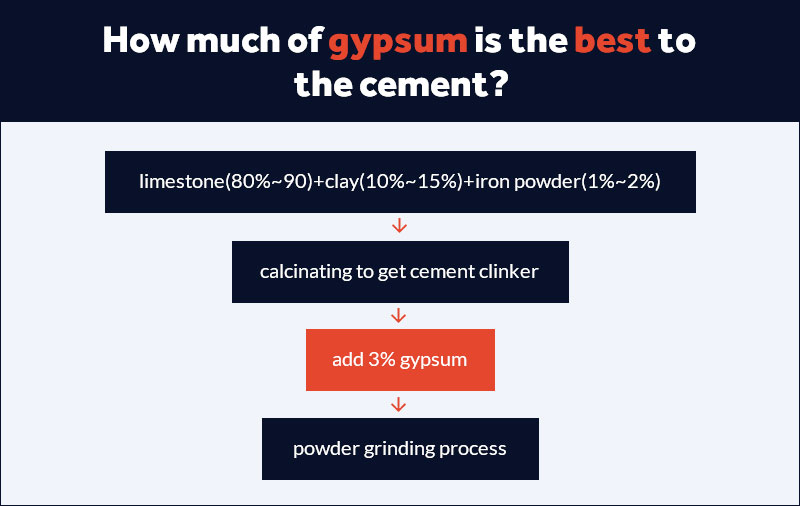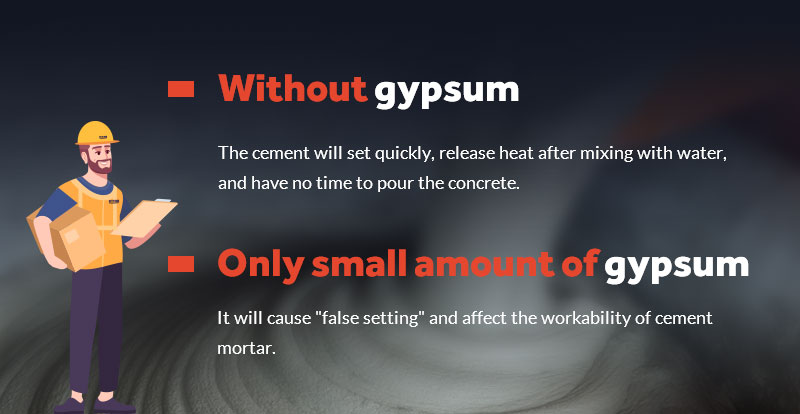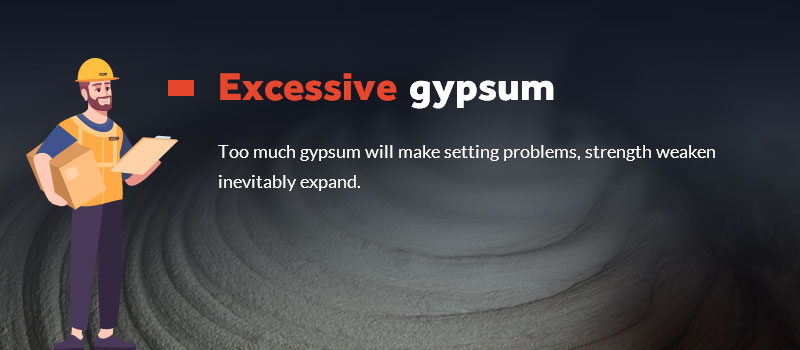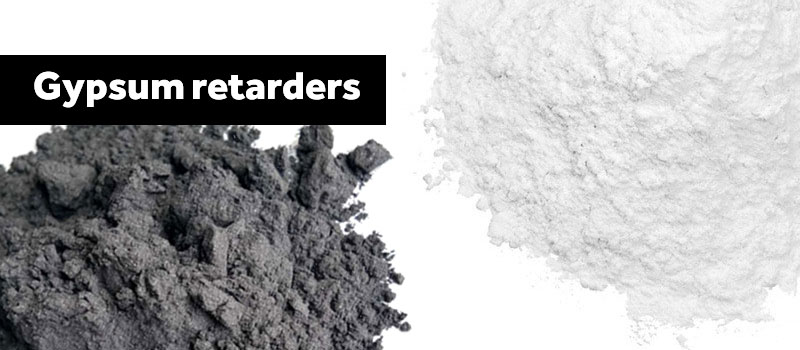Why do you need to add gypsum to cement?
The most common type of cement is Portland cement. It contains tricalcium aluminate (C3A) - one of the main components. Although C3A accounts for less than 10% of the total composition, its strong reaction with water will cause rapid solidification. The process is called "flash setting" or "the setting of the cement".
Whenever water mixes with cement, a smooth paste is formed, remaining plastic for a short time. During this period, the paste can be disturbed and remixed without injury.
As the reaction between water and cement continues, the plasticity of cement paste is lost. As a retarder, gypsum can prevent cement material from hardening so fast, and effectively control the setting time.
The retarding mechanism of gypsum is that when cement is hydrated, gypsum reacts quickly with C3A to form calcium sulfoaluminate hydrate or so-called ettringite. This ettringite initially forms very fine-grained crystals, generating a coating on the surface of C3A particles.
The whole setting process will complete quickly in a short time so that there is no time for transportation, mixing, and placement. The transportation and storage time affect the concrete strength.
To maintain the plasticity and workability of the cement mixture, the addition of gypsum can effectively adjust the rapid setting.
When is gypsum added to the cement and how much is the best?
Add gypsum after cooling the clinker
Specific types of cement are somewhat different in material processing stages and production processes.
For example, high alumina cement is made of limestone and bauxite. First, bauxite and limestone are calcined to obtain clinker, then grind the clinker to become the primary raw material for the manufacture of aluminate cement.
Besides, limestone (80% to 90%, mass fraction, the same below), clay (10% to 15%), and iron ore powder (1% to 2%) are also applied in the cement manufacturing process.
To control the setting rate, after the cement clinker is cooled, 3% gypsum is added to the clinker, and then the mixture is sent to the final grinding process.

Keep the amount of gypsum added between 3% and 4%
Plaster of Paris quickly becomes dihydrate gypsum. Adding a small amount of cement to the dihydrate gypsum will increase the overall cement hardness in the latter.
The model should keep moist after the plaster is getting hard. It takes a long time for the cement to hydrate and harden and needs enough water to ensure hydration.
For ordinary Portland cement, the addition of gypsum is kept between 3% and 4%, while for quick-setting cement, the gypsum addition can be 2.5%.
If your cement contains a lot of C3A, it may react with excess sulfate in gypsum to form ettringite. The volume of ettringite will expand, causing the gypsum to crack.
What if not or only a small amount of gypsum is added to the cement?

Without gypsum, the cement will set immediately and release heat after mixing with water, and there will be no time to pour the concrete. The main reason is that C3A in the clinker can quickly dissolve in water, forming a hydrated calcium aluminate- a coagulant that can destroy the properties of cement.
Cement production has about 4% gypsum (dihydrate gypsum) itself to adjust the setting time of cement.
A large amount of cement powder only with a small amount of plaster of Paris will form what the cement industry calls a "false setting". That will affect the workability of cement mortar and cause construction difficulties.
What are the consequences of adding too much gypsum?

In principle, adding excess gypsum would delay the setting time more than usual.
However, this is not the case. Adding excessive gypsum will accelerate the setting time because gypsum will produce coagulant thus causing the cement to set quickly, weaken its strength and inevitably expand. The reason is that water occupies a lot of voids, and when the water is lost, the concrete structure will become loose.
What is the tensile strength of cement after adding gypsum?
The ratio between compressive and flexural strength for normal-weight concrete is 6:8, whereas for lightweight concrete with porous aggregates, it is 9:12.
Gypsum concrete which is based on water resistance of gypsum-based binders is applied for the production of walling blocks and panels in non-load-bearing structures and envelopes.
Lightweight energy-saving gypsum-based cement with high-performance properties are of primary interest for construction practices. Different existing lightweight gypsum-based composites permit big savings on energy in the production of modules and in the performance of the products.
| Compressive strength of gypsum-based concrete | ||||
|---|---|---|---|---|
| Binder | Normal-weight concrete | Fine-grained concrete | Porous mineral | Organic |
| Building gypsum | 4.5...8 | 2...8 | 3...9 | 2.5...4 |
| High strength gypsum | 15...30 | 3...15 | 3.5...20 | 3.5...5 |
| Anhydrite | 7...15 | 2...12.5 | 3.5...15 | 3...7.5 |
| Estrich plaster | 4.5...8 | 2...13.5 | - | - |
| Composite binder(water resistant) | 9...35 | 5...25 | 5...22 | 3.5...9.5 |
| Data from Dvorkin, L., Dvorkin, O., 2011. Building Mineral Binding Materials. Infra-Ingeneria, Moscow, pp. 27–90 (in Russian). | ||||
Review of the effect of gypsum on cement
- 1Gypsum prevents flash setting of cement during manufacturing
- 2It retards the setting time of cement
- 3Water mixes with cement aluminates and sulfates, which will generate reaction and release some heat. Gypsum acts as a coolant to bring down the heat of hydration.
- 4Allows a longer working time for mixing, transporting and placing.
- 5Gypsum cements process considerably greater strength and hardness when compared to non-gypsum cement.
- 6Water required in gypsum based cement for hydration process is less.
Help you choose a high-quality gypsum retarder
Since the quality of different gypsum powder production processes including crushing, grinding and calcining are different, the standards and consistency used are also different.

High-quality gypsum retarders generally undergo some rigorous testing, such as the use of SEM scanning electron microscopy, MIP mercury intrusion measurement technology.
These test methods are used to detect the effect of retarders on the early liquid phase supersaturation, crystal morphology of building gypsum hydration, the effect of the pore structure of the hardened body, etc. So, they can eventually reach the best state.
The most common types of gypsum retarders are white and brown, and they are powdery and easily soluble in water. Gypsum retarders are mainly used in cement and plaster building materials.
At present, the most popular cement retarder is phosphogypsum retarder. It is a secondary resource with great development potential and a high utilization rate. It really helps a lot to produce good cement products.

